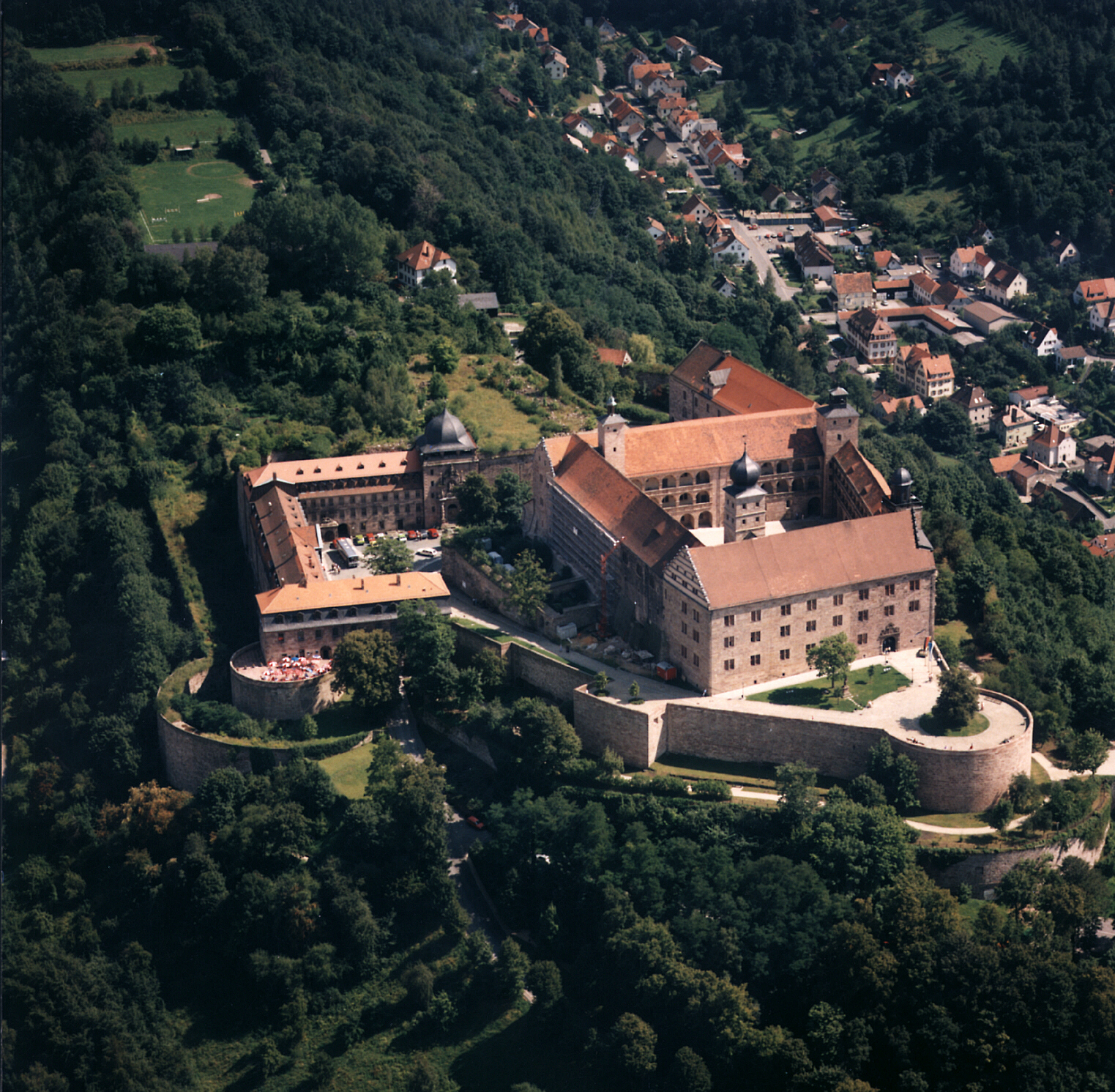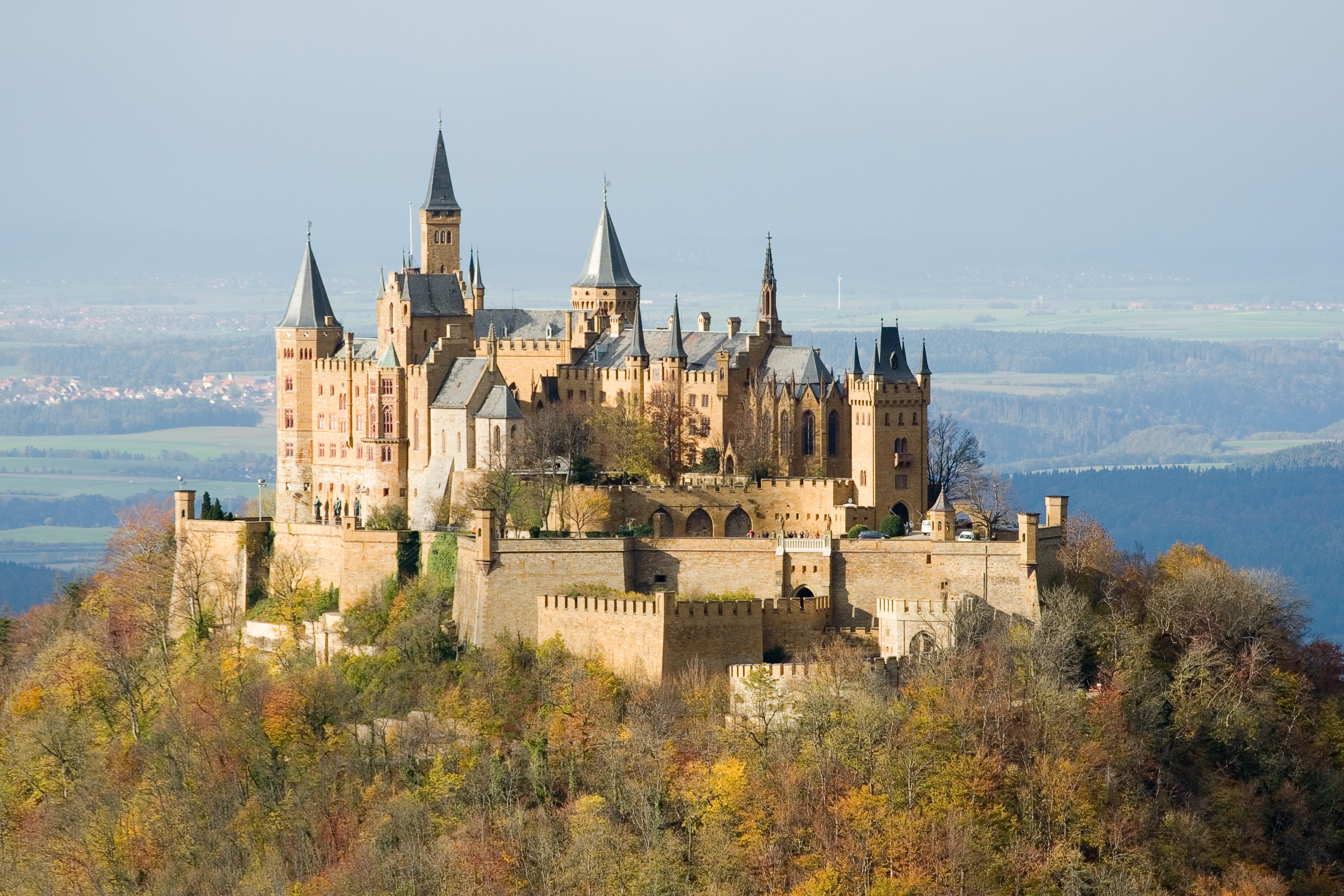|
Plassenburg
Plassenburg is a castle in the city of Kulmbach in Bavaria. It is one of the most impressive castles in Germany and a symbol of the city. It was first mentioned in 1135. The Plassenberg family were Ministerialis, ministerial of the counts of Andechs (later the dukes of Duchy of Merania, Andechs-Meranien) and used as their seat the Plassenburg. The House of Guttenberg, a prominent Franconian noble family, traces its origins back to 1149 with a Gundeloh v. Blassenberg (Plassenberg). The name Guttenberg is derived from Guttenberg, Bavaria, Guttenberg and was adopted by a Heinrich von Blassenberg around 1310. From 1340, the Hohenzollerns governed from Plassenburg castle their territories in Franconia till 1604. The Plassenburg was fortress and residence for the Hohenzollerns. It was destroyed in 1554 at the end of the second Margravian war (1552–1554) of margrave Albert Alcibiades. The Plassenburg was later rebuilt by the architect Caspar Vischer as an impressive stronghold and a ... [...More Info...] [...Related Items...] OR: [Wikipedia] [Google] [Baidu] |
Kulmbach
Kulmbach () is the capital of the district of Kulmbach in Bavaria in Germany. The town, once a stronghold of the Principality of Bayreuth, is renowned for its University of Life Sciences, a branch of the University of Bayreuth, the massive Plassenburg Castle, which houses the largest tin soldier museum in the world, for its brewery, its vivid food industry, which hosts some of the world's biggest food businesses, and for its sausages, or '' Bratwürste''. Geography Location Kulmbach is located in the middle of the Bavarian province of Upper Franconia, about northwest of the city of Bayreuth. To the south of Kulmbach, the River Main begins at the confluence of its headstreams, the White Main and Red Main. Town districts Kulmbach is divided into the following districts (with population in brackets): History From about 900 AD there was a small settlement in what is now the district of Spiegel, which consisted of a forest lodge and a fortified tenant farm (''Fronhof'') to ... [...More Info...] [...Related Items...] OR: [Wikipedia] [Google] [Baidu] |
Kulmbach (district)
Kulmbach is a ''Landkreis'' (district) in Bavaria, Germany. It is bounded by (from the north and clockwise) the districts of Kronach, Hof, Bayreuth and Lichtenfels. History The historical centre of the region was the castle of Plassenburg in the city of Kulmbach. In 1135 this castle was first mentioned. The rulers of the castle and the surrounding lands were the counts of Andechs (1135–1248, from 1135 to 1180 Dießen-Andechs, from 1180 to 1248 Andechs-Meranien) and the Thuringian counts of Orlamünde (1260–1340). After the death of the last count of Orlamünde the region fell to the Hohenzollern state. In 1398 the Hohenzollern state was divided, and in the Franconian area the two states of Ansbach and Kulmbach were founded. When the Hohenzollern family was awarded the margravate of Brandenburg, these states were called Brandenburg-Ansbach and Brandenburg-Kulmbach, but not united with Brandenburg proper. In 1603 the castle of Plassenburg was abandoned, and the capital was m ... [...More Info...] [...Related Items...] OR: [Wikipedia] [Google] [Baidu] |
Hohenzollern
The House of Hohenzollern (, ; , ; ) is a formerly royal (and from 1871 to 1918, imperial) German dynasty whose members were variously princes, electors, kings and emperors of Hohenzollern, Brandenburg, Prussia, the German Empire, and Romania. The family came from the area around the town of Hechingen in Swabia during the late 11th century and took their name from Hohenzollern Castle. The first ancestors of the Hohenzollerns were mentioned in 1061. The Hohenzollern family split into two branches, the Catholic Swabian branch and the Protestant Franconian branch,''Genealogisches Handbuch des Adels, Fürstliche Häuser'' XIX. "Haus Hohenzollern". C.A. Starke Verlag, 2011, pp. 30–33. . which ruled the Burgraviate of Nuremberg and later became the Brandenburg-Prussian branch. The Swabian branch ruled the principalities of Hohenzollern-Hechingen and Hohenzollern-Sigmaringen until 1849, and also ruled Romania from 1866 to 1947. Members of the Franconian branch became Margrave of ... [...More Info...] [...Related Items...] OR: [Wikipedia] [Google] [Baidu] |
Otto III, Count Of Weimar-Orlamünde
Otto III. Weimar-Orlamünde, sometimes called ''Otto IV'' (1244 – June 1285) was a German nobleman. He was a member of the House of Ascania and a titular Count of Weimar-Orlamünde. He was the ruling Count of Weimar and Lord of Rudolstadt and Plassenburg. Life He was the son of Count Herman II and his wife, Beatrix of Andechs-Merania. In 1248, Otto III and his elder brother Herman III inherited the Franconian possessions of their maternal uncle Otto II. They divided their possessions, with Otto receiving Weimar, Rudolstadt and Plassenburg Plassenburg is a castle in the city of Kulmbach in Bavaria. It is one of the most impressive castles in Germany and a symbol of the city. It was first mentioned in 1135. The Plassenberg family were Ministerialis, ministerial of the counts of And ... and Herman receiving Orlamünde. On 29 December 1279, Otto III founded Himmelskron Abbey. He died in June 1285, and was buried in the collegiate church of the abbey. Marriag ... [...More Info...] [...Related Items...] OR: [Wikipedia] [Google] [Baidu] |
Hermann III, Count Of Weimar-Orlamünde
Herman III, Count of Weimar-Orlamünde ( – 1283) was a member of the Weimar-Orlamünde branch of the House of Ascania. Life Herman III "the Elder", was a son of Herman II (d. 1247) and his wife, Beatrix of Andechs-Merania (d. 1265). Hermann and his brother Otto III jointly inherited the Franconian possessions of their maternal uncle Otto II. They resided at the Plassenburg. In 1278, Hermann and Otto divided their inheritance. Otto III took the County of Weimar and the Plassenburg; Hermann III took the County of Orlamünde. Hermann III died of the plague in 1283. Marriage and issue His wife, whose name is unknown, a Lady from the House of Candia-Merania, died after 21 July 1279. They had four children: # Elisabeth "the Elder" (d. before 24 March 1333), married: ## Hertmann I of Lobdeburg-Arnshaugk (d. 20 February 1289) ## Albert II, Margrave of Meissen (d. 20 November 1315) # Herman V (before 1287 – after 1312) # Henry III (d. after 26 March 1354), succeeded his ... [...More Info...] [...Related Items...] OR: [Wikipedia] [Google] [Baidu] |
Bad Berneck Im Fichtelgebirge
Bad Berneck im Fichtelgebirge () is a spa town in the Bayreuth (district), district of Bayreuth, in Bavaria, Germany. It is situated on the White Main river, in the Fichtel Mountains, 13 km northeast of Bayreuth. It lies in the northern part of the Bavarian province of Upper Franconia. Since 1857 it has been a spa, initially based on its climate and whey products. In 1930 it became a Kneipp spa and, in 1950, a Kneipp health spa. Geography The town of Bad Berneck lies on the western edge of the Fichtel Mountains in the Ölschnitz (White Main), Ölschnitz valley, which enters the White Main below the old town or ''Altstadt''. The ''Mainberg'' (624 m above Normalnull, NN) and ''Wolfenberg'' (598 m above NN) are the highest peaks in the parish. Neighbouring communities Bad Berneck's neighbouring parishes (in clockwise order) are: Gefrees, Goldkronach, Bindlach, Harsdorf, Himmelkron and Marktschorgast. The town of Bayreuth is about from Bad Berneck. Sub-divisions ... [...More Info...] [...Related Items...] OR: [Wikipedia] [Google] [Baidu] |
John II Of Nuremberg
John II of Nuremberg ( 1309 – 1357) was a Burgrave of Nuremberg from the House of Hohenzollern. He was the elder son of Frederick IV of Nuremberg and Margarete of Görz. Life He succeeded his father in 1332. He attained his name "the Acquirer" (German: der Erwerber) by the increase of the Frankish house possession of the Hohenzollern. From determining meaning the acquisition of the castle Plassenburg in Kulmbach with the county of Kulmbach by the contract of inheritance which became effective with the extinction of the present owners, the counts of Orlamünde in 1340. The Plague In the time of his government, came the outbreak of the Black Death, which claimed numerous victims in Nuremberg. Because the Jewish population was held responsible for the epidemic, numerous Nuremberg Jews were murdered, without the burgrave intervening against it. Family and children He married countess Elisabeth of Henneberg, daughter of Berthold VII, Count of Henneberg-Schleusingen, before 3 ... [...More Info...] [...Related Items...] OR: [Wikipedia] [Google] [Baidu] |
House Of Guttenberg
The House of Guttenberg is a wealthy Franconian family that was noble until all legal privileges of royalty and nobility were abolished in Germany in 1919 following the German revolution of 1918–1919, German revolution and Proclamation of the republic in Germany, proclamation of the republic at the end of World War I. It traces its origins back to 1149 with a Gundeloh von Blassenberg (Plassenberg), though the first mention in a document is dated 1158. The name Guttenberg is derived from Guttenberg, Bavaria, Guttenberg in present-day Bavaria, and it was adopted by a Heinrich von Blassenberg around 1310. History The Plassenberg family members were ''Ministerialis, ministeriales'' of the Counts of Andechs (later the Dukes of Duchy of Merania, Andechs-Meranien) and used as their seat the Plassenburg of Kulmbach. The castle of Guttenberg remains the main seat of the family. The family currently consists of two branches: the elder branch, Nobiliary particle#Germany and Austri ... [...More Info...] [...Related Items...] OR: [Wikipedia] [Google] [Baidu] |
Guttenberg, Bavaria
Guttenberg () is a municipality in the district of Kulmbach Kulmbach () is the capital of the district of Kulmbach in Bavaria in Germany. The town, once a stronghold of the Principality of Bayreuth, is renowned for its University of Life Sciences, a branch of the University of Bayreuth, the massive Plasse ... in Bavaria in Germany. The town is closely tied to House of Guttenberg, who have been associated with the locality since the Middle Ages and still own most of the land in the area. A landmark in the municipality is the :de:Burg_Guttenberg_(Oberfranken), Guttenberg Castle, the seat of the Guttenberg family. The municipality's coat of arms is derived from that of the Guttenberg family. Famous people * Enoch zu Guttenberg (1946–2018), conductor * Karl-Theodor zu Guttenberg (born 1971), his son, Christian Social Union in Bavaria, CSU politician and former Federal Minister. Neighbourhoods Guttenberg is made up of the following neighbourhoods: References Kulmba ... [...More Info...] [...Related Items...] OR: [Wikipedia] [Google] [Baidu] |
Otto VI, Count Of Weimar-Orlamünde
Otto is a masculine German given name and a surname. It originates as an Old High German short form (variants ''Audo'', '' Odo'', '' Udo'') of Germanic names beginning in ''aud-'', an element meaning "wealth, prosperity". The name is recorded from the 7th century ( Odo, son of Uro, courtier of Sigebert III). It was the name of three 10th-century German kings, the first of whom was Otto I the Great, the first Holy Roman Emperor, founder of the Ottonian dynasty. The Gothic form of the prefix was ''auda-'' (as in e.g. '' Audaþius''), the Anglo-Saxon form was ''ead-'' (as in e.g. '' Eadmund''), and the Old Norse form was '' auð-''. Due to Otto von Bismarck, the given name ''Otto'' was strongly associated with the German Empire in the later 19th century. It was comparatively frequently given in the United States (presumably in German American families) during the 1880s to 1890s, remaining in the top 100 most popular masculine given names in the US throughout 1880–1898, but its ... [...More Info...] [...Related Items...] OR: [Wikipedia] [Google] [Baidu] |


